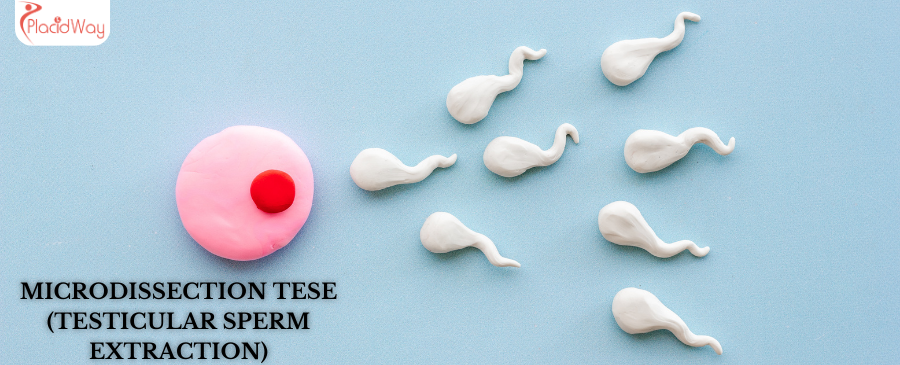
Finding Hope: Your Guide to Microdissection TESE for Male Infertility Abroad
The journey to parenthood can sometimes present unexpected challenges, and for many couples, male infertility can be a significant hurdle. When a diagnosis of azoospermia – the complete absence of sperm in the ejaculate – is made, it can feel like a devastating blow. However, advancements in reproductive medicine offer solutions, and one of the most promising for severe male factor infertility is Microdissection Testicular Sperm Extraction, or Micro-TESE.
Micro-TESE is not just a procedure; it's a meticulously performed microsurgical technique designed to give men with non-obstructive azoospermia (NOA) the best possible chance of biological fatherhood. Unlike older, "blind" biopsy methods, Micro-TESE allows a highly trained urologist to carefully examine testicular tissue under a powerful operating microscope, pinpointing areas where sperm production might still be occurring, even in small pockets. This precision minimizes damage to healthy tissue and significantly increases the likelihood of finding sperm, which can then be used for In Vitro Fertilization (IVF) with Intracytoplasmic Sperm Injection (ICSI).
Understanding the condition, the procedure, and where to find world-class care, particularly through medical tourism, can empower you to make informed decisions. This comprehensive guide will walk you through everything you need to know about Micro-TESE, from its underlying causes and symptoms to recovery, costs, and why many international patients are choosing to pursue this life-changing treatment abroad.
What are the Symptoms of Male Infertility and Azoospermia?
For most men, the primary "symptom" of male infertility, including azoospermia, is simply the inability to achieve pregnancy with a fertile female partner after a sustained period (typically 6-12 months) of regular, unprotected intercourse. Unlike other medical conditions, there are often no noticeable physical signs or discomforts that indicate a man has a fertility issue.
However, in some cases, men might experience subtle indicators related to the underlying cause of their infertility. These can include:
- Problems with sexual function: Such as difficulty with ejaculation, low sex drive, or erectile dysfunction.
- Pain, swelling, or a lump in the testicle area: This could be due to conditions like varicocele (enlarged veins in the scrotum) or other testicular issues.
- Recurrent respiratory infections: In rare cases, genetic conditions like cystic fibrosis can affect both the lungs and reproductive system, leading to obstructive azoospermia.
- Inability to smell (anosmia): This can be a symptom of Kallmann syndrome, a genetic condition that affects hormone production necessary for sperm development.
- Abnormal breast growth (gynecomastia): Can be linked to hormonal imbalances.
- Decreased facial or body hair: Another potential sign of hormonal issues.
For azoospermia specifically, the diagnosis is made through a semen analysis. If two separate analyses show no sperm, further investigations, including blood tests for hormone levels and genetic testing, will usually follow to determine if the azoospermia is obstructive (sperm are produced but blocked from exiting) or non-obstructive (sperm production is severely impaired or absent).
What Causes Azoospermia in Men? Understanding the Risk Factors
Azoospermia can be broadly classified into two main types:
- Obstructive Azoospermia (OA): Sperm are produced in the testicles but cannot exit due to a blockage in the reproductive tract (e.g., vasectomy, infection, congenital absence of the vas deferens).
- Non-Obstructive Azoospermia (NOA): This is when the testicles do not produce enough sperm, or produce no sperm at all, often due to severe impairment of sperm production. Micro-TESE is primarily used for NOA.
Causes and risk factors for NOA can be complex and include:
- Genetic factors:
- Klinefelter syndrome: A chromosomal condition (XXY) affecting male sexual development.
- Y chromosome microdeletions: Missing sections on the Y chromosome crucial for sperm production.
- Other genetic mutations: Affecting genes involved in spermatogenesis.
- Hormonal imbalances:
- Hypogonadism: Low testosterone due to problems with the pituitary gland or hypothalamus (e.g., Kallmann syndrome).
- Exposure to exogenous hormones: Such as anabolic steroids.
- Testicular issues:
- Undescended testicles (cryptorchidism): If not corrected early in life.
- Testicular trauma or torsion: Injury or twisting of the testicle.
- Orchitis: Inflammation of the testicles, often due to infection (e.g., mumps).
- Varicocele: Enlarged veins in the scrotum, which can affect sperm production, though its link to NOA is debated.
- Chemotherapy or radiation therapy: Cancer treatments can severely damage sperm-producing cells.
- Environmental factors:
- Exposure to certain toxins or heavy metals.
- Excessive heat exposure to the testes (e.g., from certain occupations, hot tubs).
- Idiopathic Azoospermia: In a significant number of cases, despite extensive investigation, no specific cause for NOA can be identified.
A thorough diagnosis by a fertility specialist is crucial to understand the specific cause of azoospermia and determine the most appropriate treatment path.
Types of Sperm Retrieval Procedures Available for Male Infertility
When natural ejaculation doesn't yield sperm, various surgical techniques can be employed to retrieve sperm directly from the reproductive tract. These methods are typically paired with IVF/ICSI (Intracytoplasmic Sperm Injection) to achieve pregnancy. Here are the main types:
- Testicular Sperm Aspiration (TESA): A needle is inserted into the testis to aspirate tissue and fluid. It's less invasive but less effective for NOA.
- Percutaneous Epididymal Sperm Aspiration (PESA): A needle is inserted into the epididymis (the coiled tube behind the testicle that stores and carries sperm) to retrieve sperm. This is typically used for obstructive azoospermia.
- Conventional Testicular Sperm Extraction (TESE): A small incision is made in the testis, and small pieces of testicular tissue are removed and examined for sperm. It's done without microscopic guidance.
- Microdissection Testicular Sperm Extraction (Micro-TESE): This is the gold standard for non-obstructive azoospermia. A small incision is made, and under a high-powered operating microscope, the surgeon meticulously searches for seminiferous tubules that appear enlarged and healthy, as these are more likely to contain sperm. This targeted approach is less damaging to the testis and significantly improves the chances of finding sperm compared to conventional TESE for NOA patients.
For men with NOA, Micro-TESE offers distinct advantages:
- Higher Sperm Retrieval Rates: Studies consistently show Micro-TESE has superior success rates (often 40-60%) for finding sperm in men with NOA compared to conventional TESE (15-30%).
- Reduced Testicular Damage: The microscopic precision allows the surgeon to selectively remove only suspicious tubules, preserving more healthy testicular tissue and minimizing blood vessel damage, which can help maintain testicular function post-procedure.
- Lower Complication Rates: Due to its less invasive nature (in terms of tissue removal), Micro-TESE generally leads to fewer complications like hematoma (blood collection) or reduced testosterone production.
The choice of procedure depends on the underlying cause of azoospermia, previous attempts, and the expertise of the fertility team.
Who is a Candidate for Microdissection TESE?
Micro-TESE is specifically tailored for men facing the most challenging forms of male infertility. You might be considered a candidate for Micro-TESE if you meet the following criteria:
- Diagnosis of Non-Obstructive Azoospermia (NOA): This is the primary indication. This means that sperm are not present in your ejaculate because your testicles are not producing enough viable sperm, rather than a blockage preventing them from exiting.
- Normal Reproductive Tract Patency: Your vas deferens and epididymis are open, indicating that the problem lies with sperm production, not transport.
- Extensive Diagnostic Workup: You've undergone a comprehensive evaluation, including semen analyses, hormone tests (FSH, LH, testosterone), and potentially genetic screening (karyotype, Y-chromosome microdeletion analysis), confirming NOA.
- Genetic Conditions: Such as Klinefelter syndrome or Y-chromosome microdeletions (especially AZFc deletions), where sperm production is severely compromised but often not entirely absent in small areas.
- History of Failed Conventional TESE: If a previous conventional TESE failed to retrieve sperm, Micro-TESE may offer a higher chance of success due to its precision.
- Desire for Biological Parenthood: Couples who wish to use the male partner's genetic material for IVF/ICSI.
It's important to note that Micro-TESE may not be suitable for all men with NOA. Factors such as very high FSH levels (indicating severe testicular failure), very small testes, or specific genetic deletions (like AZFa or AZFb) might indicate an extremely low likelihood of finding sperm. A thorough consultation with a fertility specialist and urologist experienced in male infertility is essential to determine your eligibility and discuss realistic expectations.
What is the Recovery Time and What to Expect After Micro-TESE?
The recovery process after Micro-TESE is generally well-tolerated, though it requires some downtime and careful attention to post-operative instructions. Here’s what you can typically expect:
Immediately After the Procedure:
- Anesthesia Recovery: You will wake up in a recovery room. Most Micro-TESE procedures are performed under general anesthesia.
- Discomfort: You will likely experience some pain, swelling, and bruising in the scrotal area. This is normal and can be managed with prescribed pain medication.
- Scrotal Support: You will be advised to wear a scrotal support (jockstrap) for several days to weeks to reduce swelling and provide comfort.
First Few Days (Day 1-3):
- Rest: It’s crucial to rest during this period. Avoid any strenuous activity, heavy lifting, or prolonged standing.
- Ice Packs: Applying ice packs to the scrotal area (with a cloth barrier) can help reduce swelling and discomfort.
- Wound Care: Keep the incision site clean and dry. You’ll receive specific instructions on dressing changes and showering.
- Sperm Retrieval Results: You should receive information on whether sperm were successfully retrieved relatively quickly, as the retrieved tissue is usually processed immediately in the lab.
First Week (Day 4-7):
- Activity: You can gradually return to light, non-strenuous activities. Avoid heavy lifting, intense exercise, and sexual intercourse.
- Pain: Discomfort should lessen significantly, though mild tenderness and swelling may persist.
Weeks 2-4 and Beyond:
- Resumption of Activities: Most men can resume normal activities, including sexual intercourse and strenuous exercise, within 2 to 4 weeks, depending on individual healing and comfort.
- Follow-up: A follow-up appointment with your urologist is usually scheduled a few weeks after the procedure to check on healing and discuss long-term implications.
It’s vital to follow all post-operative instructions provided by your medical team to ensure optimal healing and minimize complications. Remember, every individual's recovery can vary slightly.
Understanding the Risks and Side Effects of Microdissection TESE
As with any surgical procedure, Micro-TESE carries potential risks and side effects, though the microsurgical approach helps to minimize many of them:
- Pain and Discomfort: Post-operative pain is expected and usually manageable with medication. Persistent or severe pain should be reported to your doctor.
- Swelling and Bruising: Common in the scrotal area, usually resolving within a few weeks.
- Bleeding/Hematoma: There's a risk of bleeding or a collection of blood (hematoma) within the scrotum. Severe cases may require drainage.
- Infection: Any surgical incision carries a risk of infection. Antibiotics may be prescribed pre- or post-operatively to reduce this risk.
- Testicular Damage: While Micro-TESE is designed to be tissue-sparing, there's always a minimal risk of damage to the testicular tissue, potentially affecting future natural testosterone production, though this is rare and often temporary.
- Decreased Testosterone Production: A temporary drop in testosterone levels is possible after surgery, especially if a significant amount of tissue is removed or if both testicles are operated on. In rare cases, this could be permanent, potentially requiring testosterone replacement therapy.
- Scarring: A small scar will remain on the scrotum at the incision site.
- Anesthesia Risks: Risks associated with general anesthesia, though rare, include allergic reactions, breathing problems, or heart issues.
- No Sperm Retrieval: Despite the advanced technique, there's still a chance that no viable sperm will be found. This can be emotionally challenging and highlights the importance of realistic expectations.
Your fertility specialist and urologist will thoroughly discuss these risks with you, weigh them against the potential benefits, and take all necessary precautions to ensure the safest possible outcome.
Worldwide Cost Comparison for Microdissection TESE
The cost of Microdissection TESE can be a major factor for many couples, as it is often not covered by standard health insurance plans. Prices vary dramatically based on the country, the clinic's reputation, the surgeon's experience, and what's included in the package (e.g., anesthesia, facility fees, sperm cryopreservation, pre-op tests, post-op care). Here's an estimated comparison:
| Country | Estimated Micro-TESE Cost (USD) | Notes |
|---|---|---|
| USA | $8,000 - $15,000+ | High-cost region, varies by state and clinic. Often requires separate fees for anesthesia, lab, and facility. |
| United Kingdom | $7,000 - $12,000+ (GBP equivalent) | Similar to USA, private clinics are expensive. NHS waiting lists can be long, and criteria strict. |
| Canada | $7,000 - $12,000+ (CAD equivalent) | Costs can be high in private clinics, public system coverage varies and may have wait times. |
| Turkey | $3,000 - $6,000 | A leading medical tourism destination, excellent quality for a fraction of Western costs. |
| Mexico | $3,500 - $7,000 | Popular for North American patients seeking affordable, high-quality care. |
| India | $2,500 - $5,000 | Very competitive pricing, with many internationally accredited hospitals. |
| Thailand | $4,000 - $7,500 | Renowned for medical tourism, high standards of care, and excellent patient experience. |
These figures are estimates and can fluctuate. It is always recommended to obtain detailed quotes directly from clinics, ensuring all associated costs are included.
Why Consider Microdissection TESE Abroad?
For many couples facing the daunting prospect of male infertility, seeking Micro-TESE abroad has become a compelling option. Here's why:
- Significant Cost Savings: As seen in the cost comparison, the most prominent driver is often the dramatic difference in price. You can often save 50-70% or more on the procedure compared to prices in the USA, UK, or Canada, without compromising on quality.
- Access to Expertise and Advanced Technology: Many international clinics, particularly in medical tourism hubs, boast state-of-the-art facilities and world-renowned fertility specialists and urologists who perform Micro-TESE regularly. These clinics often have high success rates due to their experience and advanced embryology labs.
- Reduced Wait Times: In many Western countries, long waiting lists for fertility treatments, including Micro-TESE, can add emotional stress and delay your family-building plans. Abroad, appointments can often be secured much more quickly.
- Privacy and Discretion: For some, the opportunity to undergo a sensitive medical procedure like Micro-TESE away from home offers a greater sense of privacy and anonymity.
- Comprehensive Packages: Many international clinics offer all-inclusive packages that cover the procedure, anesthesia, hospital stay, initial medication, and even sometimes accommodation or airport transfers, simplifying the planning process.
- High Success Rates: Clinics specializing in medical tourism often compete on quality and outcomes, leading to excellent success rates, particularly in complex procedures like Micro-TESE combined with IVF/ICSI.
- The "Vacation" Aspect: While it's a medical journey, combining treatment with travel can help alleviate some stress, offering a change of scenery and the chance to recover in a more relaxed environment.
Which Countries Offer the Best Value for Micro-TESE Treatment?
When seeking high-value, high-quality Micro-TESE abroad, certain countries consistently stand out due to their established medical tourism infrastructure and expertise in fertility treatments:
- Turkey: Particularly Istanbul, has emerged as a powerhouse in fertility treatments. Turkish clinics are known for their experienced urologists and embryologists, state-of-the-art facilities, and competitive pricing. Many clinics are internationally accredited and offer English-speaking staff.
- Mexico: Bordering the United States, Mexico is a convenient and affordable option for North American patients. Cities like Tijuana, Cancun, and Mexico City host excellent fertility clinics with modern equipment and highly trained specialists, often at a fraction of US costs.
- India: Renowned for its affordable yet high-quality medical care, India has numerous JCI-accredited hospitals offering advanced fertility treatments, including Micro-TESE. Its large pool of skilled doctors and nurses makes it a strong contender for cost-effective care.
- Thailand: With its world-class hospitals and a reputation for excellent hospitality, Thailand offers a compelling package for medical tourists. Bangkok and Phuket are home to several sophisticated fertility centers that provide advanced procedures like Micro-TESE at competitive prices, coupled with a pleasant recovery environment.
- Other European Destinations: Countries like the Czech Republic, Greece, and Spain also offer high-quality fertility treatments at more affordable prices than Western Europe or North America, with strong legal frameworks for fertility care.
When choosing a country and clinic, always research accreditations (e.g., JCI), surgeon qualifications, success rates, and patient testimonials to ensure both value and quality.
What to Expect When Traveling Abroad for Micro-TESE?
Embarking on a medical journey abroad requires careful planning and coordination. Here’s a general overview of what to expect:
- Initial Consultation & Planning:
- You'll likely have initial virtual consultations with your chosen international clinic to discuss your medical history, diagnostic tests, and eligibility.
- The clinic or a medical tourism facilitator will help you with treatment plans, cost estimates, and logistical details.
- Travel Arrangements:
- Passport and Visa: Ensure your passport is valid, and check if you need a visa for your chosen destination.
- Flights and Accommodation: Book flights and arrange lodging that is convenient to the clinic. Many clinics or facilitators offer assistance with this.
- Travel Insurance: Consider medical travel insurance that covers unforeseen circumstances.
- Upon Arrival:
- Airport Transfer: Some clinics offer airport pick-up services.
- Pre-Procedure Appointments: You'll have in-person consultations, physical exams, and possibly repeat diagnostic tests to confirm everything before the Micro-TESE.
- The Procedure and Recovery:
- Surgery Day: The Micro-TESE procedure will be performed.
- Hospital Stay: You might have a short hospital stay (often overnight) for monitoring.
- Initial Recovery: Plan for at least 1-2 weeks in the destination for initial recovery and follow-up appointments, especially since the sperm retrieval and subsequent IVF/ICSI might be coordinated.
- Sperm Use for IVF/ICSI:
- If sperm are found, they will be cryopreserved (frozen) for future use with your partner's IVF cycle. This might mean your partner also travels for egg retrieval, or sperm is shipped back (though shipping human tissue internationally is complex and regulated).
- Post-Procedure Support:
- Before returning home, ensure you have all necessary medical reports, follow-up instructions, and contact information for your medical team abroad.
Open communication with your chosen clinic is key throughout this entire process.
How to Ensure Safety and Quality for Micro-TESE Abroad?
Ensuring that your medical journey abroad is both safe and of high quality is paramount. Here are key steps to take:
- Check for International Accreditations: Look for clinics accredited by reputable international bodies like the Joint Commission International (JCI) or local national accreditations recognized globally. These ensure adherence to stringent patient safety and quality-of-care standards.
- Verify Surgeon's Qualifications and Experience:
- Research the urologist or fertility surgeon who will perform your Micro-TESE. Verify their board certifications, specialized training in male infertility and microsurgery, and how many Micro-TESE procedures they perform annually. Experience directly correlates with success rates for this complex procedure.
- Ensure they are part of a multi-disciplinary team, including embryologists and reproductive endocrinologists.
- Review Clinic Success Rates: Ask for the clinic's specific Micro-TESE sperm retrieval rates, especially for men with NOA. Also inquire about their IVF/ICSI success rates when using sperm retrieved via Micro-TESE. Be wary of clinics that provide vague or unrealistic figures.
- Read Patient Testimonials and Reviews: Search for reviews on independent platforms, forums, and social media. Look for consistent positive feedback regarding patient care, communication, and surgical outcomes.
- Understand the Facility and Technology: Ensure the clinic has a well-equipped operating room, a sophisticated embryology lab (essential for processing retrieved sperm and performing ICSI), and uses modern microscopic equipment for Micro-TESE.
- Clear Communication: Ensure there are clear channels of communication, especially if there's a language barrier. The clinic should offer English-speaking staff or professional medical interpreters.
- Pre- and Post-Operative Care Plan: Discuss the detailed plan for your pre-operative assessment, the procedure itself, immediate post-operative care, and long-term follow-up.
- Consider a Medical Tourism Facilitator: Reputable facilitators like PlacidWay can help you vet clinics, arrange logistics, and act as an advocate, simplifying the process and providing an extra layer of confidence.
Don't hesitate to ask detailed questions and seek multiple opinions before making your decision.
What Are Patient Success Stories from Abroad for Micro-TESE?
The journey through male infertility and azoospermia can be isolating, but hearing about others' triumphs can offer immense hope. While specific names and personal details are confidential, numerous couples have shared powerful narratives of finding success through Micro-TESE abroad:
A Couple from the UK Finds Affordable Expertise in Turkey:
"After years of trying and a devastating diagnosis of non-obstructive azoospermia, we felt our dreams of having a biological child were slipping away. The cost of Micro-TESE in the UK was prohibitive, and the waiting lists felt endless. We decided to look abroad and discovered a clinic in Istanbul. The level of care, the surgeon's expertise, and the modern facilities were beyond our expectations, and the cost was less than half of what we were quoted back home. They found sperm! We're now proud parents, and we couldn't be more grateful for taking that leap of faith."
A US Couple's Journey to Parenthood in Mexico:
"My husband's NOA diagnosis was tough. We explored options in the US, but the costs were astronomical. A friend recommended looking into fertility clinics in Mexico. We chose a clinic in Tijuana after extensive research. The doctors were incredibly compassionate, and the entire process, from initial consultation to the Micro-TESE itself, was seamless. They successfully retrieved sperm, and we're now preparing for our IVF cycle. It shows that world-class care isn't just limited to your home country, and it can be affordable too."
Overcoming Odds in Thailand:
"We were told our chances of finding sperm with my husband's severe NOA were very low. In Australia, we faced long waits and high costs. We decided to try a highly specialized clinic in Bangkok. The team was exceptional, using the latest Micro-TESE techniques. They managed to find viable sperm, and the empathy and support we received made a huge difference. Our journey wasn't easy, but the professionalism and care we received abroad helped us finally achieve our dream."
These stories underscore the potential for medical tourism to provide not just a treatment, but a pathway to a family for those facing complex fertility challenges.
Take the Next Step with PlacidWay
Ready to explore treatment options abroad? Discover top clinics, compare prices, and get a free quote tailored to your needs with PlacidWay.
Fertility Treatment Abroad, Best Fertility Clinics










Share this listing